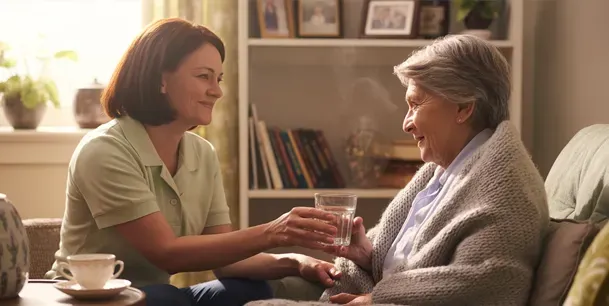The demand for home health aides (HHAs) is growing fast. According to the U.S. Bureau of Labor Statistics (BLS), employment for home health and personal care aides is projected to grow by 21% from 2023 to 2033. With an aging population and a greater need for in-home care, becoming a certified HHA can lead to a stable and fulfilling career.
But before you can start working, you need to pass the HHA certification exam. Many people feel anxious about the home health aide certification test online because they don’t know what to expect or how to prepare. That’s where practice tests can help. They give you a clear idea of the exam format, strengthen your knowledge, and build your confidence.
Using practice tests, you can identify your strengths, find areas that need work, and improve your chances of passing. So, what’s included in these practice tests, and how can they help you succeed? Let’s explore.
Read More: How to Get a HHA Certificate
Why Are Home Health Aide Practice Tests Important?
A home health aide certification test online is a set of questions designed to help you get ready for the actual HHA certification exam. The practice tests include multiple-choice and scenario-based questions that cover important topics like patient care, safety, nutrition, and medical procedures.
Many online platforms and training programs offer these practice tests to help students understand what to expect in the real exam.
Preparing well through practice tests can also open the door to a rewarding career. In fact, the median yearly salary for home health and personal care aides was $33,530 in May 2023, highlighting the value of this important role in healthcare.
Read More: What is HHA Certification?
1. Helps You Understand the Exam Format
The real HHA exam has multiple-choice questions that test your knowledge. When you take practice tests, you will learn how the exam is structured and what types of questions to expect.
2. Identifies Your Weak Areas
Practice tests show which topics you need to study more. If you get a low score in a section, you can focus on improving that area before the real exam.
3. Increases Confidence
Taking practice tests regularly helps you feel more comfortable with the exam format. The tests reduce stress and improve your confidence on the actual test day.
4. Improves Time Management
The real home health aide certification test online has a time limit. Practice tests help you learn how to answer questions quickly and efficiently within the given time.
Topics Covered in Home Health Aide Practice Tests
Home health aide certification test online cover a variety of topics to ensure you are fully prepared. Such topics help you understand patient care, safety, medical procedures, and communication skills. Below are the key areas covered in the tests.
1. Patient Care
Home Health Aides assist patients with personal hygiene tasks like bathing, brushing teeth, and combing hair. They also help with dressing to ensure patients are clean and comfortable.
Some patients have difficulty moving due to age, illness, or disability. HHAs help them walk, move from bed to a chair, and perform simple exercises to maintain muscle strength.
Proper hygiene prevents infections. HHAs must wash their hands often, wear gloves when needed, and clean equipment properly. They also help patients maintain cleanliness to avoid illnesses.
2. Safety and Emergency Procedures
Many elderly and disabled patients are at risk of falling. HHAs must ensure the home environment is safe by removing obstacles, keeping floors dry, and using assistive devices like walkers.
HHAs should know how to identify signs of medical emergencies such as strokes, heart attacks, or difficulty breathing. Quick action can save lives.
Knowing first aid helps in minor injuries like cuts or burns. CPR (Cardiopulmonary Resuscitation) is key when a patient stops breathing. HHAs must be trained to respond correctly.
3. Nutrition and Meal Preparation
Patients need proper nutrition to stay healthy. HHAs should prepare meals that include proteins, carbohydrates, vitamins, and minerals according to dietary needs.
Some patients have medical conditions that require special diets. For example, diabetics need low-sugar meals, while heart patients require low-sodium diets. HHAs must follow these guidelines carefully.
Patients with swallowing difficulties or weakness may need assistance while eating. HHAs should encourage slow eating, use special utensils if necessary, and monitor for choking risks.
4. Basic Medical Knowledge
HHAs often check patients’ vital signs to monitor health conditions. They should know how to measure temperature, pulse rate, respiration, and blood pressure accurately.
Early detection of health problems can prevent complications. HHAs should watch for symptoms like fever, dizziness, pain, or unusual changes in behavior.
Although HHAs do not give medications, they remind patients to take them on time. They must also report any side effects or missed doses to a nurse or caregiver.
5. Communication and Ethics
Clear and respectful communication is important in-home care. HHAs should listen to patients, speak kindly, and update family members about any concerns.
HHAs must respect patient confidentiality. They should never share personal health information without permission.
Patients come from different backgrounds and may have unique beliefs about health and illness. HHAs should respect these differences and provide care accordingly.
Read More: What Is An Assisted Living Facility? Costs, Benefits And Services
How to Prepare for Home Health Aide Practice Tests
Engaging in practice exams familiarizes candidates with the test format and question types, reducing anxiety and improving confidence. This targeted preparation often leads to higher pass rates and a more successful certification process.
1. Study HHA Course Materials
The best way to prepare is by reading course materials. Textbooks, class notes, and online resources cover all the important topics. Focus on patient care, safety, nutrition, and medical procedures. Reviewing official guidelines will also help you understand best practices in home healthcare.
2. Take Online Practice Tests
Practice tests are available on many websites. They simulate the real exam and give you a clear idea of the types of questions you will face. Taking multiple tests can help track your progress and build confidence.
3. Review Your Mistakes
After each practice test, go through the questions you answered incorrectly. Understand why you made a mistake and learn the correct answer. This will help you avoid similar errors in the actual exam.
4. Use Flashcards
Flashcards, especially when combined with spaced repetition techniques, have been shown to enhance learning and memory retention significantly. For example, a 2015 study at Washington University School of Medicine found that medical students who utilized Anki, a popular flashcard application, experienced a one-point increase on their licensing exams for every 1,700 unique flashcards reviewed.
5. Watch Training Videos
Watching videos about patient care, safety measures, and medical procedures can improve understanding. Many online platforms provide step-by-step demonstrations that make learning easier.
6. Join Study Groups
Studying with others helps you stay motivated. In a group, you can discuss difficult topics, ask questions, and quiz each other. Learning from others can make studying more effective.
7. Take Notes and Summarize
Writing short summaries of each topic can help you remember key points. Instead of reading long paragraphs, break down information into simple notes that you can review quickly before the exam.
8. Manage Your Time
Practice answering questions within a time limit. The actual exam is timed, so learning to manage your time effectively will help you complete all questions before time runs out.
Read More: Who Are Home Caregivers? All You Need To Know
Home Health Aide (HHA) Practice Test: Are You Ready to Pass?
Preparing for your home health aide certification test online? Do you know how often to reposition a bedridden patient? What should you do first in an emergency? Test your knowledge with these realistic practice questions covering patient care, safety, nutrition, communication, and emergency action plans. Let’s see how well you do!
Section 1: Basic Patient Care
1. When assisting a client with bathing, what should you do first?
A) Apply lotion to the skin
B) Check the water temperature
C) Help the client undress immediately
D) Pour soap into the water
Answer: B) Check the water temperature
Always check the water temperature before a bath to prevent burns or discomfort. Use a thermometer or test it with your wrist to ensure it’s warm but not too hot.
2. A client is bedridden and unable to turn on their own. How often should they be repositioned?
A) Every 8 hours
B) Every 6 hours
C) Every 2 hours
D) Only when they feel discomfort
Answer: C) Every 2 hours
Repositioning every two hours prevents pressure sores (bedsores), which develop when the skin and underlying tissue are damaged due to prolonged pressure.
Section 2: Infection Control & Safety
3. What is the best way to prevent the spread of infection?
A) Wear gloves at all times
B) Wash hands before and after patient contact
C) Use hand sanitizer instead of washing hands
D) Avoid touching the patient
Answer: B) Wash hands before and after patient contact
Handwashing is the most effective way to prevent infections. It removes germs, bacteria, and viruses that can be passed to patients. Always wash hands with soap and water for at least 20 seconds.
4. When lifting a heavy object, what should you always do?
A) Bend at the waist and lift with your back
B) Keep your feet close together
C) Use your leg muscles and keep your back straight
D) Lift as quickly as possible
Answer: C) Use your leg muscles and keep your back straight
Bending at the knees and using your legs prevents back injuries. Keeping the object close to your body and maintaining a straight back reduces strain.
Section 3: Nutrition & Hydration
5. A client with difficulty swallowing (dysphagia) should have what type of diet?
A) Regular solid food
B) Pureed or soft food
C) Only liquids
D) No dietary restrictions
Answer: B) Pureed or soft food
Clients with dysphagia are at risk of choking. Soft or pureed foods make swallowing easier and safer. Thickened liquids may also be recommended.
6. How can you help a client who is at risk for dehydration?
A) Offer fluids regularly, even if they don’t ask
B) Wait until they say they are thirsty
C) Limit fluid intake to avoid bathroom accidents
D) Give only thickened liquids
Answer: A) Offer fluids regularly, even if they don’t ask
Older adults or ill patients may not feel thirsty but still need fluids to prevent dehydration, which can cause confusion, dizziness, and kidney problems.
Section 4: Communication & Client Rights
7. If a client refuses care, what should you do?
A) Insist that they accept care
B) Report the refusal to your supervisor
C) Ignore the refusal and provide care anyway
D) Threaten to leave them alone
Answer: B) Report the refusal to your supervisor
Clients have the right to refuse care. If this happens, document the refusal and report it to your supervisor so appropriate actions can be taken.
8. A client confides in you about being abused by a family member. What should you do?
A) Keep it confidential and do nothing
B) Tell another client about it
C) Report it to your supervisor immediately
D) Wait until the client mentions it again
Answer: C) Report it to your supervisor immediately
Abuse must be reported immediately to protect the client. Home health aides are mandatory reporters, meaning they are legally required to report suspected abuse.
Section 5: Emergency Procedures & Vital Signs
9. Which vital signs should you report immediately to a nurse or supervisor?
A) Pulse rate of 72 bpm
B) Blood pressure of 118/78 mmHg
C) Temperature of 102°F (38.9°C)
D) Respiratory rate of 16 breaths per minute
Answer: C) Temperature of 102°F (38.9°C)
A fever over 100.4°F (38°C) is a sign of infection or illness. A temperature of 102°F or higher requires immediate medical attention.
10. If a client begins choking and cannot speak or cough, what should you do first?
A) Call 911 immediately
B) Perform the Heimlich maneuver (abdominal thrusts)
C) Give the client a glass of water
D) Pat them gently on the back
Answer: B) Perform the Heimlich maneuver (abdominal thrusts)
If a person cannot cough, speak, or breathe, they have a complete airway blockage. Performing the Heimlich maneuver (abdominal thrusts) helps remove the object from the airway.
Scoring Guide:
9-10 correct: Excellent! You are well-prepared.
7-8 correct: Good! Review key concepts to improve.
5-6 correct: Fair. More studying is needed.
Below 5: Focus on learning the basics before taking the test.
Read More: What Are Residential Assisted Living Facilities?
Your Path to Success in the HHA Exam
Practice questions are an important step when you are preparing for home health aide certification test online. They help you understand the exam format, improve your knowledge, and boost your confidence. Using study materials, taking practice tests, and following the right preparation strategy, you can pass the HHA exam successfully.
If you are serious about becoming a certified HHA, start with online caregiver training and practice with questions provided in this guide. Take the first step toward a rewarding career in home healthcare!
References:


.webp)










